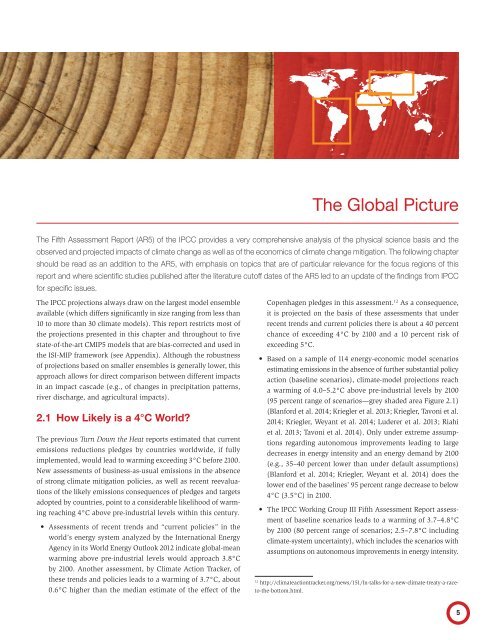1JF6e15
1JF6e15
1JF6e15
Create successful ePaper yourself
Turn your PDF publications into a flip-book with our unique Google optimized e-Paper software.
The Globa l Picture<br />
The Fifth Assessment Report (AR5) of the IPCC provides a very comprehensive analysis of the physical science basis and the<br />
observed and projected impacts of climate change as well as of the economics of climate change mitigation. The following chapter<br />
should be read as an addition to the AR5, with emphasis on topics that are of particular relevance for the focus regions of this<br />
report and where scientific studies published after the literature cutoff dates of the AR5 led to an update of the findings from IPCC<br />
for specific issues.<br />
The IPCC projections always draw on the largest model ensemble<br />
available (which differs significantly in size ranging from less than<br />
10 to more than 30 climate models). This report restricts most of<br />
the projections presented in this chapter and throughout to five<br />
state-of-the-art CMIP5 models that are bias-corrected and used in<br />
the ISI-MIP framework (see Appendix). Although the robustness<br />
of projections based on smaller ensembles is generally lower, this<br />
approach allows for direct comparison between different impacts<br />
in an impact cascade (e.g., of changes in precipitation patterns,<br />
river discharge, and agricultural impacts).<br />
2.1 How Likely is a 4°C World?<br />
The previous Turn Down the Heat reports estimated that current<br />
emissions reductions pledges by countries worldwide, if fully<br />
implemented, would lead to warming exceeding 3°C before 2100.<br />
New assessments of business-as-usual emissions in the absence<br />
of strong climate mitigation policies, as well as recent reevaluations<br />
of the likely emissions consequences of pledges and targets<br />
adopted by countries, point to a considerable likelihood of warming<br />
reaching 4°C above pre-industrial levels within this century.<br />
• Assessments of recent trends and “current policies” in the<br />
world’s energy system analyzed by the International Energy<br />
Agency in its World Energy Outlook 2012 indicate global-mean<br />
warming above pre-industrial levels would approach 3.8°C<br />
by 2100. Another assessment, by Climate Action Tracker, of<br />
these trends and policies leads to a warming of 3.7°C, about<br />
0.6°C higher than the median estimate of the effect of the<br />
Copenhagen pledges in this assessment. 12 As a consequence,<br />
it is projected on the basis of these assessments that under<br />
recent trends and current policies there is about a 40 percent<br />
chance of exceeding 4°C by 2100 and a 10 percent risk of<br />
exceeding 5°C.<br />
• Based on a sample of 114 energy-economic model scenarios<br />
estimating emissions in the absence of further substantial policy<br />
action (baseline scenarios), climate-model projections reach<br />
a warming of 4.0–5.2°C above pre-industrial levels by 2100<br />
(95 percent range of scenarios—grey shaded area Figure 2.1)<br />
(Blanford et al. 2014; Kriegler et al. 2013; Kriegler, Tavoni et al.<br />
2014; Kriegler, Weyant et al. 2014; Luderer et al. 2013; Riahi<br />
et al. 2013; Tavoni et al. 2014). Only under extreme assumptions<br />
regarding autonomous improvements leading to large<br />
decreases in energy intensity and an energy demand by 2100<br />
(e.g., 35–40 percent lower than under default assumptions)<br />
(Blanford et al. 2014; Kriegler, Weyant et al. 2014) does the<br />
lower end of the baselines’ 95 percent range decrease to below<br />
4°C (3.5°C) in 2100.<br />
• The IPCC Working Group III Fifth Assessment Report assessment<br />
of baseline scenarios leads to a warming of 3.7–4.8°C<br />
by 2100 (80 percent range of scenarios; 2.5–7.8°C including<br />
climate-system uncertainty), which includes the scenarios with<br />
assumptions on autonomous improvements in energy intensity.<br />
12<br />
http://climateactiontracker.org/news/151/In-talks-for-a-new-climate-treaty-a-raceto-the-bottom.html.<br />
5


